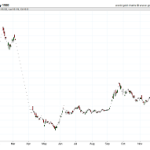Silver prices have been subject to various economic and political events that have influenced their movements over the years. The year 1984 saw silver prices fluctuate throughout the year, with prices ranging from $6.68 oz to $7.92 oz. These fluctuations were affected by supply and demand, as well as speculation and other factors.
Tracking silver prices can provide valuable insights into economic health and inflation, making it an important indicator to monitor for investors and policymakers alike. In this article, we will explore the historical trends and factors that influenced silver prices in 1984. We will examine the various economic and political events that impacted the supply and demand of silver, as well as the role of speculation in shaping silver prices.
Additionally, we will compare the 1984 silver prices to current prices to provide a broader understanding of the changes and trends in the silver market over the years. By analyzing the fluctuations and trends of 1984 silver prices, we can gain a deeper understanding of the factors that influence silver prices and their implications for the economy and investors.
Overview of 1984 Prices
In 1984, the prices of silver fluctuated throughout the year, with the highest price of $7.92 oz on August 16 and the lowest price of $6.68 oz on December 14, according to daily price records. The prices were influenced by various factors such as supply and demand, economic and political events, and speculation. These fluctuations had historical significance and impacted investment decisions, as silver prices can be used as an indicator of economic health and inflation.
Investors and traders closely monitor silver prices to make informed investment decisions. The fluctuations in silver prices in 1984 were significant for investors as they provided an opportunity to buy or sell silver at different prices. Investors who accurately predicted the market trends were able to make a profit. On the other hand, those who made incorrect assumptions lost money.
Therefore, understanding historical silver prices and their fluctuations is crucial for making informed investment decisions.
Factors Affecting Prices
Various economic and political events, as well as supply and demand dynamics, have been identified as key factors that impact the value of silver.
The supply of silver is influenced by factors such as mining production, recycling, and government stockpiling. On the other hand, demand for silver is driven by industrial uses, jewelry, and investment purposes. The balance between supply and demand is a crucial determinant of silver prices.
For instance, if the supply of silver exceeds demand, prices are likely to fall, while a shortage of silver can lead to price increases. Economic events also play a significant role in determining silver prices.
For example, changes in interest rates, inflation, and currency exchange rates can affect the demand for silver as an investment asset. Inflationary pressures tend to increase demand for silver as a hedge against currency devaluation, while rising interest rates can reduce demand for silver as investors shift to higher-yielding assets.
Additionally, political events such as trade disputes, geopolitical tensions, and government policies can also impact silver prices. For instance, trade tensions between major economies can lead to a decline in industrial demand for silver, while government policies such as stimulus measures can boost demand for silver as an inflation hedge.
Comparison to Current Prices
The value of silver is impacted by a multitude of factors, including economic events, political tensions, and supply and demand dynamics. As such, the fluctuations in silver prices in 1984 may not be directly comparable to the current prices.
However, understanding the historical significance of silver prices can provide insight into the economic implications of the metal’s value.
In recent years, silver prices have been influenced by global economic events such as the COVID-19 pandemic, as well as political tensions and changes in government policies. The demand for silver has also been affected by the growth of renewable energy sources, which require silver for production.
The current silver prices can be used as an indicator of economic health and inflation, as well as a tool for investors to diversify their portfolios. Overall, while the fluctuations in silver prices may not be directly comparable to those of 1984, understanding the factors that influence the value of silver can provide valuable insights into the current economic climate.
Frequently Asked Questions
What was the global demand for silver in 1984 and how did it affect prices?
Despite the irony of silver being a precious metal, the global demand for it in 1984 was actually quite modest. Supply chain disruptions may have affected prices, but other factors such as economic and political events also played a role.
Were there any major political events or crises in 1984 that impacted silver prices?
The 1984 political climate did not have a significant impact on silver prices. Prices fluctuated throughout the year due to supply and demand, economic factors, and speculation. The highest price was $7.92 oz on Aug 16, and the lowest was $6.68 oz on Dec 14.
How did the price of silver in 1984 compare to the price of other precious metals during the same period?
How did silver prices in 1984 compare to gold and platinum prices? Silver prices were lower than gold and platinum prices in 1984. This impacted the jewelry industry, as silver was a more affordable option for consumers.
Were there any significant changes in silver production or mining during 1984 that impacted prices?
There is no evidence to suggest that any significant changes in silver production or mining occurred during 1984 that impacted prices. Silver production innovations and mining company mergers may have affected prices in the long term, but not within this specific year.
How did the fluctuations in the price of silver in 1984 impact the overall economy and other industries?
The fluctuations in the silver market trends in 1984 had a significant impact on various industries and the economy. The economic impact was felt as prices rose and fell, affecting sectors such as technology, manufacturing, and jewelry.





